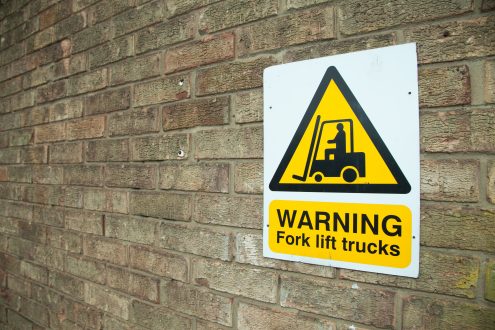Preparing your forklift for ice & snow
According to OSHA, the American equivalent of the HSE, 11% of forklift trucks will be involved in an accident each year, and 50% of these accidents could have been avoided if the operators had received adequate training.
Many of these accidents will occur during the winter months, when the weather takes a turn for the worst. Operators who are not trained or experienced at using a forklift in snow, ice and freezing temperatures can experience a whole host of seasonal problems that could affect the safe and efficient use of forklift trucks.
The only way to ensure business continues as normal is to make sure your staff are attentive to the change in environment and are trained well enough to adapt their working processes.
The first step is to ensure your operators can recognise and identify winter hazards. These include:
- Cold weather, snow and ice
- Wet and slippery conditions
- Limited visibility
These hazards can be addressed by ensuring both your operators and your forklifts trucks are properly prepared and protected.
Operator Protection
Working in cold and freezing conditions can affect the concentration levels of even the most experienced forklift operative. As an employer it is your job to ensure they are properly kitted out to stay warm and safe, and able to concentrate on the job at hand.
Providing windproof coats, multiple warm layers of clothing, hats and gloves will keep your workers protected from the cold weather, allowing them to continue working comfortably.
As visibility is sometimes restricted in bad weather, you should also ensure any clothing you provide is highly visible and reflective.
You should also encourage your operatives to take regular breaks someplace warm, away from the constant mental and physical strain of the weather.
If the forklift doesn’t have a screen or cab, consider upgrading your forklift or having screens with wipers and heaters fitted.
Forklift Protection
Preparing your forklift for use in winter weather is equally as important as preparing your operatives.
- Investing in high quality, forklift covers to keep them protected from the wind and rain.
- Pneumatic tyres*, rather than solid tyres can provide more stability in bad conditions.
- If pneumatic tyres aren’t appropriate, tyre chains and studs* will provide additional grip if the ground is covered in ice or snow.
- Ensure your yard is effectively gritted when frosts and snow are predicted and maintain a level of gritting to stop vehicles and pedestrians from slipping.
*If in doubt, always check with your forklift manufacturer or in the handbook to see which type of tyres are most suitable for your truck.
Forklift Operation
Before you begin working on a forklift in winter, check the lighting. Can additional floodlighting be arranged to ensure adequate visibility? If the weather is icy or wet, ensure the forklift cover is on, and check the tyres are suitable for the weather (pneumatic/studs/chains).
Check fuel, oil and de-icer levels and always allow time for the forklift to warm up before use to keep the hydraulics and engine at optimal performance.
Whilst in use, you should be extra vigilant. Harsh weather can cause pedestrians and other operatives to be distracted. The wind and rain could mean they are rushing and that their hearing and visibility is restricted. Operatives should slow down, ensure they can always see where they are going and keep an eye out for slippery surfaces, obstacles and distracted pedestrians.
After use, clean the forklift down and ensure any necessary maintenance is carried out. This won’t affect the operative’s immediate safety, but salt from gritting and a buildup of dirt could affect the safe use of the forklift in the future.
Forklift Attachments
It is commonplace for many workplaces to use their forklifts to clear snow and ice, but to do so you will need the proper attachments.
A plow will help to remove snow from the yard and parking areas and a scoop can pile the snow in a corner of the yard to keep the grounds clear and safe. You could also use a salter or sander to grit your parking, loading and working areas to increase overall safety.
Any operatives using these attachments should be properly trained in their safe use.
Forklift Maintenance
Winter maintenance of your forklift is essential to keep it functioning and safe to use. A breakdown at any time of year can be costly, but this is especially true if you are relying on your forklifts to keep your yard running smoothly over winter.
You should ensure that all annual servicing and regular inspections are up to date.
Your forklifts should be stored in a dry area, and if necessary, use the battery warmer (or keep it plugged in) to avoid a flat battery.
Ensure you are using diesel suitable for freezing temperatures and use a high quality hydraulic fluid. Some additives are available to stop the fuel from freezing or gelling.
For more information about training your operatives to safely use and inspect forklifts during the colder months, simply get in touch with the team at Health and Safety Training Ltd. We have years of experience tailoring our forklift training courses and refresher courses to suit your exact requirements, so you can rely on us to ensure your operatives are fully prepared for the cold, wet and wintery weather.
The hidden danger of asbestos in the workplace Train your way out of unemployment






